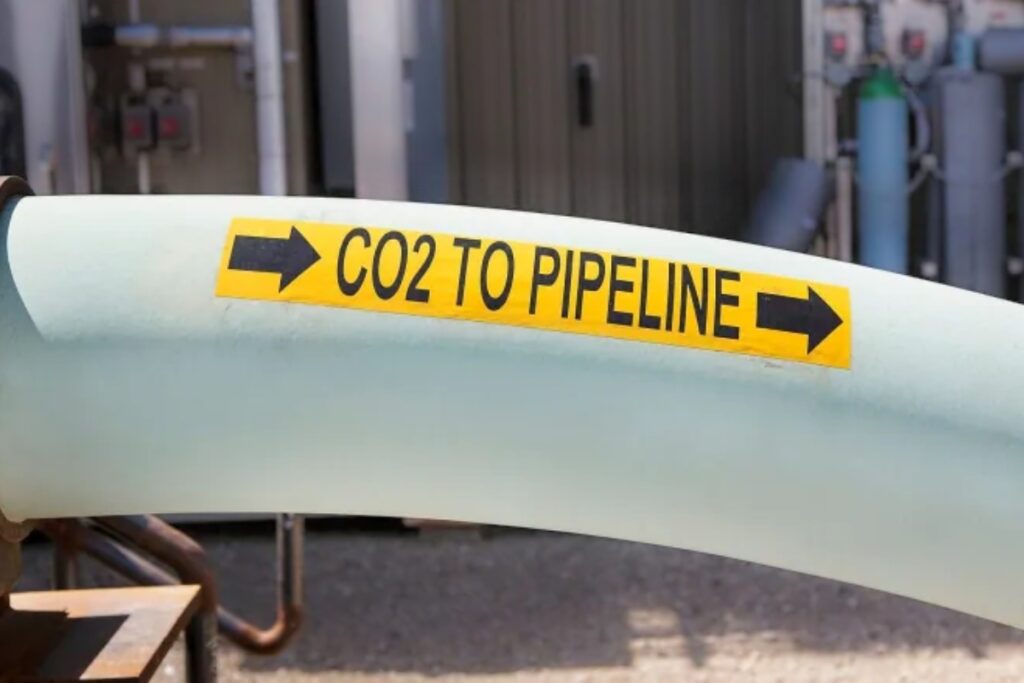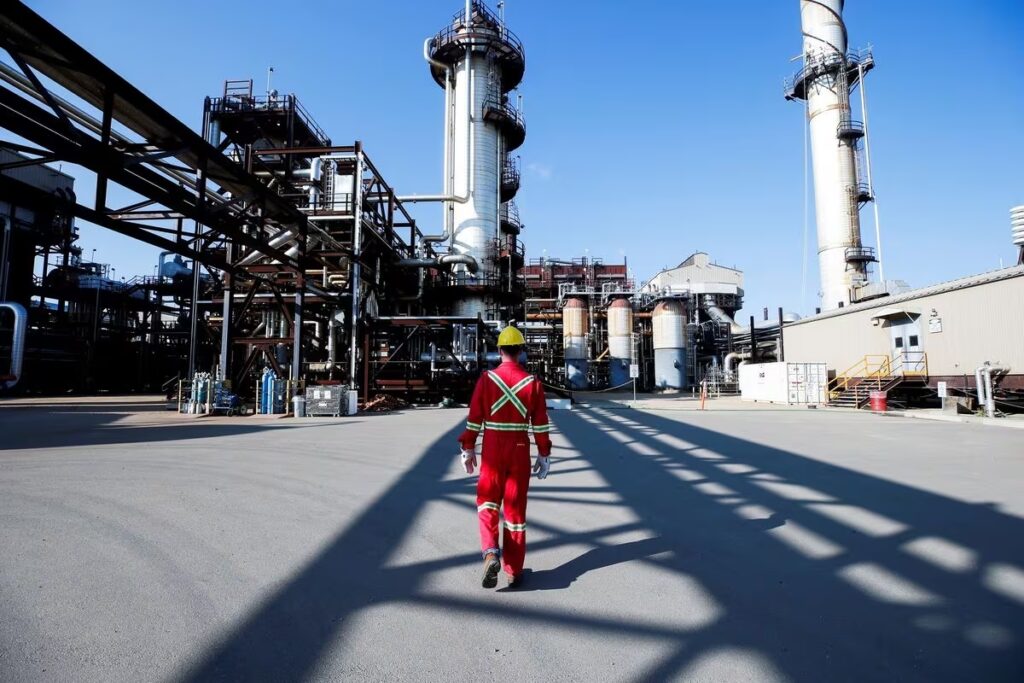Oscar Judelson-Kelly: New federal policies are a good start, but more needs to be done to ensure Canadian carbon capture can compete with the US.

A carbon capture pipe at the Quest CCS project in Fort Saskatchewan. Photo by Shell Canada.
By Resource Works
More News and Views From Resource Works Here
Canadians are worried about climate change. Carbon dioxide (CO2) is being released into the atmosphere in all areas of life, from industrial uses to individual daily demands. Simply shutting down our economy to address the impacts of climate change isn’t an acceptable solution. But what if there was a way to capture the carbon emitted?
Good news: there is.
It’s a technology called carbon capture and storage, and there are some 265 such projects in operation or in various stages of development around the world.
More good news: the carbon capture market is growing. In 2022, it was worth US$2.1 billion. Less than a decade later, the sector is forecasted to grow to US$7.49 billion by 2030.
What is carbon capture and storage?
There are two varieties of carbon capture:
- Carbon capture and storage (CCS) is a process in which CO2 from power generation or industrial activity, such as steel cement or natural gas production, is captured and subsequently permanently stored and sequestered underground.
- Carbon Capture, Utilisation and Storage (CCUS) is a process in which the CO2 may be stored deep underground or in geological formations, or may be used for industrial purposes such as fertilizer production, synthetic fuel production, or boosting oil recovery in old wells.
Also, CO2 can either be captured at industrial projects or can be removed directly from the atmosphere via Direct Air Capture (DAC) technology.
Canada has been a leader in the first generation of CCS development and is home to five of the 30 commercial CCS projects worldwide that have safely stored over 44 million tonnes of CO2 since their inception.
For a country with only under 0.5% of the world’s population, building 16% of the world’s top CCS projects isn’t a bad record. The carbon captured is equivalent to the emissions reductions obtained by taking over 9.4 million cars off the road. However, this is just the tip of the spear.
According to the CCS Knowledge Centre, “Canada’s current federal emissions reduction plan expects national carbon capture and storage (CCS/CCUS) capacity to more than triple, adding facilities to capture and store at least 15 million tonnes per year by 2030.”
The federal government’s Carbon Management Strategy includes some incentives to drive investment in carbon capture projects, with a promised investment tax credit for anticipated CCUS projects.
A Canadian story

A Shell employee at the Quest Carbon Capture and Storage facility. Photo from Reuters.
Canada has a habit of exporting good ideas. A tragically Canadian legacy, the country also has a long history of seeing its innovations suffer at home and thrive abroad.
For instance, one of the largest projects in CCS development is Occidental Petroleum’s US$1-billion STRATOS project in Texas, which aims to remove a remarkable 500,000 tons of CO2 from the atmosphere a year once fully operational in 2025. This project also happens to be the largest DAC project yet.
And STRATOS will have some Canadian help from an early mover in direct air capture of CO2. That’s Carbon Engineering, based in Squamish, BC.
The company began with a pilot plant in 2015 that extracts CO2 from the air and produces transportation fuels from the byproduct. Carbon Engineering followed up with its Carbon Engineering Innovation Centre in 2021. And now, they provide technological support to Occidental Petroleum’s Texas plant.
Then there’s Quebec-based startup Deep Sky, which aims to build plants to scrub CO2 from air and sea, transforming the captured CO2 into minerals and storing it underground. Through this process, Deep Sky hopes to obtain carbon credits and sell the credits to entities aiming to meet emissions-reduction obligations.
The latest Canadian proposal is the Solid Carbon Project. The project would extract CO2 from the atmosphere using DAC technology powered by wind turbines floating in the ocean. The captured carbon would then be injected into basalt rock formations, where the CO2 would react and eventually — over 10 to 25 years — turn into rock.
“This technology has ultimate durability because it will react with the basalt, form rock, and never go back into the atmosphere,” says Kate Moran, Project Lead at Solid Carbon.
Solid Carbon has its eyes on the Cascadia Basin, some 300 kilometres southwest of Vancouver Island. Moran said the basalt there has the capacity to store 750 gigatons of CO2 — the equivalent of roughly 15 to 20 years of global CO2 emissions.
Closer to home, GeoScienceBC is supporting geological CCS research in BC. This research could lead to carbon sequestration in sedimentary basins and carbon mineralization, where CO2 becomes a solid mineral when exposed to certain rocks.
Yet Alberta is undoubtedly the national leader in carbon capture. The government of Alberta invested $1.24 billion for up to 15 years in the Quest and Alberta Carbon Trunk Line projects, which have captured and stored a total of more than 11.5 million tonnes of CO2 since 2015. Alberta is looking into another 25 potential CCS projects, miles ahead of British Columbia when it comes to carbon management and carbon capture.
CCS is also a key for the Pathways Alliance, a partnership of Canada’s largest oilsands companies with goals that include achieving net-zero emissions from operations by 2050.
The Alliance’s “foundational project” is a 400-kilometre CO₂ transportation line that could eventually link over 20 CCS facilities with a carbon-storage hub in northeastern Alberta.
Pathways is still waiting for the federal government to finish hammering out the details of its new investment tax credit for carbon capture and storage.
But many closest to the developing CCUS industry in Canada fear investment will flow to the US, where the financing can be more attractive, especially if Ottawa fails to act more decisively. Despite scientific expertise at home, Canada may find itself losing its edge to US execution once again.
The US Inflation Reduction Act provides enhanced tax credits that more than double the net value of Canada’s CCUS Investment Tax Credit (ITC). In response, Canada needs to do more to incentivize companies to build carbon capture projects, which can be extremely costly.
A related issue is the timelines the federal government has created for the ITCs for carbon capture projects. Unfortunately, the ITCs may not last long enough to be as impactful as hoped, especially considering the long wait times required by carbon capture project development, thanks in part to governmental red tape.
However, as various carbon capture projects make progress, this also presents a tremendous opportunity to learn from other projects in Canada and around the world. Cory Channon, International Director of Climate Change Policy Solutions at the International Brotherhood of Boilermakers, said that as “the appreciation for knowledge sharing grows, there is an opportunity to share internationally.” Consistent reporting can “prevent redundancies, optimize benefits, and ensure overall efficiency while preparing us to speak clearly with the world about what we have learned.”
Meanwhile, Alex Pourbaix, chair of Cenovus, one of Canada’s largest companies in the oil patch, says the sector could remove a significant amount of carbon with just a fraction of the billions of dollars that Ottawa is spending to build the battery industry. It could also generate thousands of Canadian jobs, instead of importing temporary foreign workers.
Carbon management, including carbon capture, is a critical piece of global climate action. That’s a sentiment shared by the Intergovernmental Panel on Climate Change (IPCC) and the International Energy Agency (IEA), which maintains there is no credible path to net-zero emissions without the rapid scaling of carbon management technologies.
It’s good to see the federal government supporting the technology. The government of Alberta is demonstrating exemplary leadership in this field. Yet more needs to be done, including in British Columbia and in Ottawa, to ensure that yet another instance of Canadian innovation doesn’t bow out after the first act.
Oscar Judelson-Kelly is Resource Work’s Communications and Policy Coordinator.
Share This:




